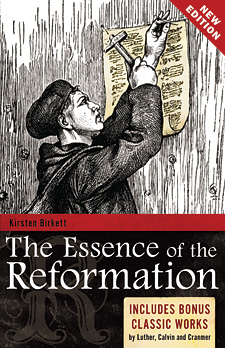Wheldon Curzon-Hobson writes that Kirsten Birkett's Essence of the Reformation has some of the smell but not much of the substance of this complex historical period.
The 14th century in Europe was an age of questioning and challenging. A number of influential men within the church such as Huss in Bohemia and Wycliffe in England, were demanding a re-evaluation of church doctrine and practice. The treasures of ancient Greek were beginning to influence art and scholarship. Princes and their states were developing a greater sense of unique identity, old ideas were being questioned, and artists were freely expressing themselves in new ways.
This was the Europe into which the movements of 15th century Reformation, Renaissance and Humanism were to battle against each other and the established powers. Fuelled by the use of the printing press, the new political movements, the oppressed position of the peasantry, and the vast wealth of the new merchants and bankers, there evolved a titanic struggle that resulted in social, religious and political upheaval, transformation, violence and uncertainty.
 Reformation thinkers such as Luther, who argued that salvation came through an individual relationship with God, rather than through the sacraments of the church, had a huge influence. Their belief was based upon the Bible being the sole authority, rather than the church. This theology of individual grace started with Luther's argument with the church over the sale of indulgences, but was soon broadened against many of the established practices of the church.
Reformation thinkers such as Luther, who argued that salvation came through an individual relationship with God, rather than through the sacraments of the church, had a huge influence. Their belief was based upon the Bible being the sole authority, rather than the church. This theology of individual grace started with Luther's argument with the church over the sale of indulgences, but was soon broadened against many of the established practices of the church.
Luther's arguments, which became ever more inflammatory, were taken up by the peasantry, who used them to violently rebel against the oppressive practices of the church. They were also used by the princes to rebel against the rule of the Emperor and the church, and Calvin, another Reformist writer, had his writings used to support the rising power of capitalism.
Given that the Reformation was both an influence upon, and was strongly influenced by, the turmoil of its historical setting, Kirsten Birkett has written an unnervingly short, overwhelmingly positive account of this period of church history. She presents the good, but not much of the bad or the ugly. She outlines much of what was wrong with the existing church and generally only portrays the positive influence of the non-establishment leaders of the Reformation. She doesn't go into any detail about the many significant attempts by the church to reform itself from within, the splits within the leadership of the Reformation over important points of doctrine, or the violence and oppression that was created as a direct result of the writings of the frequently dogmatic and oppressive leaders of the Reformation.
The Reformation was a dynamic, painful, incredibly important time for the history of Europe and the church. The positive message of the Reformation leaders, both within and outside of the established church, certainly does need to be expressed. However, the historical and religious context in which it was conceived was broader and more complex than Birkett offers us here.




















